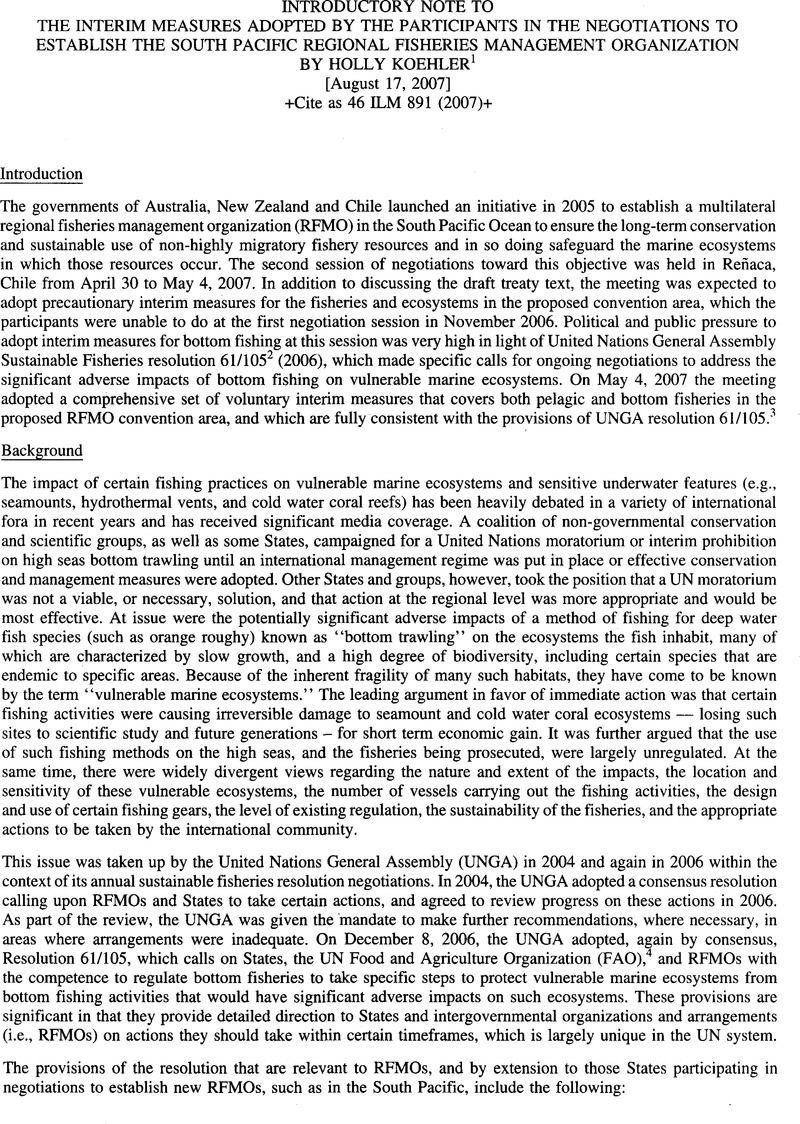No CrossRef data available.
Article contents
Interim Measures Adopted by the Participants in the Negotiations to Establish the South Pacific Regional Fisheries Management Organization
Published online by Cambridge University Press: 27 February 2017
Abstract

- Type
- Judicial and Similar Proceedings
- Information
- Copyright
- Copyright © American Society of International Law 2007
Footnotes
This text was reproduced and reformatted from the text appearing at the following website <<http://www.southpacificrfmo.org/assets/Third%20International%20Meeting/Final%20SP3%20Report_Renaca.DOC>
References
1 Ms.Koehler leads the U.S. delegation to the negotiations to establish the South Pacific regional fisheries management organization. She also chaired the drafting committee in Chile that developed them. Ms. Koehler has also chaired the UNGA Sustainable Fisheries resolution negotiations since 2004. The views expressed in this Note are her own and do not necessarily reflect those of the United States Government.
2 The text of UNGA Resolution 61/105 can be found at http://www.un.org/Depts/los/generaLassembly/general_assembly_resolutions.htm>.
3 The Russian Federation was the only delegation that objected to any part of the interim measures. The Russian Federation placed a reservation on paragraphs 1 and 2 of the bottom fishing measures, which limit bottom fishing to current areas being fished and to existing levels of catch or effort until 2010.
4 UNGA Resolution 61/105 requested the Food and Agriculture Organization (FAO) to develop standards and criteria for use by States and RFMOs in identifying vulnerable marine ecosystems and the impacts of fishing on such ecosystems. In March 2007, FAO agreed to develop Technical Guidelines for the management of deep sea fisheries on the high seas, including standards and criteria for identifying vulnerable marine ecosystems and the impacts of fishing activities on such ecosystems. The development of the Guidelines began with an FAO Expert Workshop, which was held in June 2007. An Expert Consultation is scheduled for September, followed by a Technical Consultation in February 2008. It is expected that the Guidelines will be completed in the first quarter of 2008. See http://www.fao.org>.
5 See http://www.seafo.org>.
6 Pursuant to article 36 of the Agreement for the Implementation of the Provisions of the United Nations Convention on the Law of the Sea of 10 December 1982 relating to the Conservation and Management of Straddling Fish Stocks and Highly Migratory Fish Stocks,1 and in accordance with paragraph 16 of General Assembly resolution 59/25, the Secretary-General convened a review conference on the Agreement four years after its entry into force. The Review Conference was held in New York from 22 to 26 May 2006. See paragraph 18(c). http://www.un.org/Depts/los/convention_agreements/review_conf_fish_stocks.htm>
* This text was reproduced and reformatted from the text appearing at the following website<http://www.southpacificrfmo.org/assets/Third%20International%20Meeting/Final%20SP3%20Report_Renaca.DOC>
1 The area is under negotiation, but for the purposes of these interim measures it will be the high seas area south of the Equator, north of the Ccamlr Convention area, east of the SIOFA Convention Area and west of the areas of fisheries jurisdictions of South American States.
2 Existing levels of fishing effort or catch means the average annual levels over the period 1 January 2002 to 31 December 2006.
3 For the Purpose of these interim measures,“vulnerable marine ecosystems” includes seamounts, hydrothermal vents cold water corals and sponge fields.




